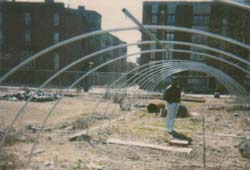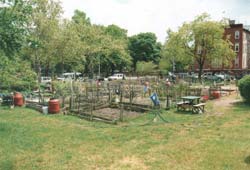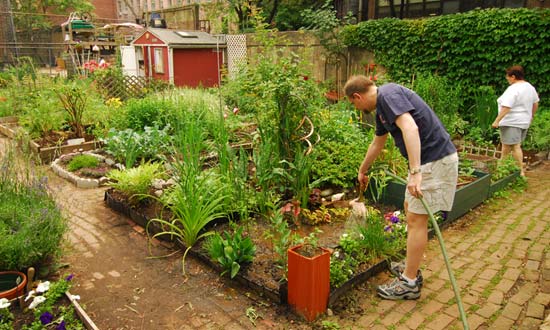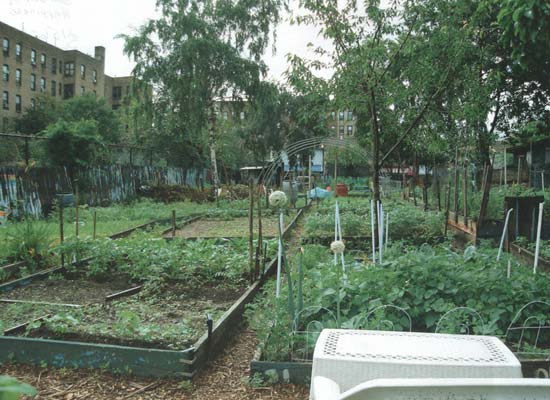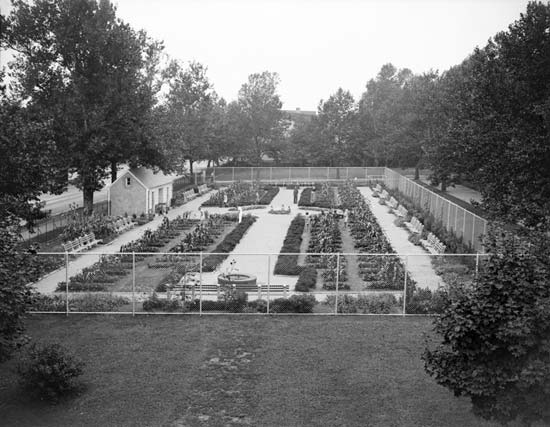Tales of Gardening Greatness
Find information about GreenThumb community gardens at the GreenThumb webpage.
There are community gardens in parks across the five boroughs, all doing their part to make the city a greener, and more collaborative, place. Here are just five of more than 600 across the city, and just a little bit of their stories:
Hattie Carthan Community Garden
Hattie Carthan Community Garden, located at Marcy and Lafayette avenues in Brooklyn, is named for Hattie Carthan (1900-1984), a Bedford-Stuyvesant resident who had a lifetime interest in trees. Mrs. Carthan replanted trees in Bedford-Stuyvesant, helped found the Bedford-Stuyvesant Neighborhood Tree Corps in 1971 as a way to teach young people how to care for trees, and became the chairwoman of the Bedford-Stuyvesant Beautification Committee–an effort that added over 1,500 trees to the neighborhood, and led the charge to preserve a particular Southern magnolia tree that became a symbol of the neighborhood.
The magnolia species that Carthan helped preserve is rarely seen in the northeast. The particular tree in front of 677 Lafayette Avenue is believed to have been brought on a ship from North Carolina in 1885. Carthan not only succeeded in having a wall built to protect the tree but also spearheaded the successful attempt to designate it an official city landmark in 1970, making it one of only two trees in the city to be designated as such (and after the 1998 death of the Weeping beech in Queens, the only tree still standing). Carthan continued her campaign by convincing the City to convert three nearby abandoned homes into the Magnolia Tree Earth Center. The brownstones on Lafayette and Marcy avenues behind Hattie Carthan Garden date to the 1880s and now feature a mural depicting Mrs. Carthan.
Hattie Carthan Community Garden was established in 1981 as the Lafayette-Marcy Garden in the Bedford-Stuyvesant section of Brooklyn. In 1985, the garden was renamed to honor Mrs. Carthan. In 1992, the site was the second GreenThumb garden to earn "preservation site" designation.
Clinton Community Garden
One of the most successful community gardens in the city, the 100-by-150-foot Clinton Community Garden, just two blocks from Times Square on West 48th Street between Ninth and Tenth avenues, has been carefully tended to by a committed neighborhood for over 30 years. The parcel on which Clinton Community Garden now thrives was once a haven for illegal activity and an eyesore for area residents. In 1978, the West 48th Street Block Association joined with the Green Guerillas to secure a lease for the site, excavate and recycle thousands of bricks to construct pathways, and grow vegetables and flowers in individual garden plots.
When the City proposed putting the property up for auction in 1981, the gardeners formed the Committee to Save Clinton Community Garden and ran a "Square Inch Campaign," in which a $5.00 donation "bought" a piece of the garden. Figuring the site comprised 2 million square inches, garden advocates attempted to raise the $900,000 (the fair market appraisal) to purchase the site from the city. Meanwhile, gardeners began writing letters to Mayor Edward I. Koch to preserve the parcel as a community garden. "Yes, we all hear the area is improving," one such letter read, "but what will that mean without a decent space, a green space, for people to relax in. Area apartments are very tiny and cramped & Central Park is rather far off and inconvenient." The story attracted national attention in magazine, newspaper, and television features, as well as the eventual personal support of Mayor Koch, who bought the first square inch of the garden. Although backers raised $100,000, they were well short of the $900,000 needed to buy the site outright by a December deadline. But in 1984, one month before the auction was to take place, the garden was transferred to Parks, making it the first community garden to become parkland.
Clinton Community Garden is now licensed to the nonprofit Clinton Community Garden, Inc., whose elected Steering Committee manages the Garden's 108 plots. Clinton Community Garden notes that an average of 500-600 people use the garden during the summer, including more than 100 children each week, and over 2,000 people have access to keys. The garden is notable in that it is open seven days a week, dawn to dusk. Programs include an annual Summer Solstice event, potluck dinners, art shows (the first taking place in 1981, featuring local artists; artist Mallory Abramson was one of the garden's founders), weddings, chamber music picnics, gardening seminars, dance recitals, and even photo shoots.
Garden of Happiness
The Garden of Happiness, located on Prospect Avenue between East 181st and East 182nd streets in the Bronx, was founded in 1988 on three city-owned lots. Its name refers simply to the hopes of area residents that the garden function as a haven from the city streets and a source of pride for the community that surrounds it. In the late 1980s, the lot was slated for development, but the project was abandoned when developers discovered that the land was embedded with bedrock. The lot began to accumulate garbage, and concerned community members built a fence around the lot and enlisted the help of Operation GreenThumb to clean up and develop the land. The Garden of Happiness was permanently assigned to the Parks Department in 1998, and in 1999 became a full-fledged Parks Property, the first Bronx garden to be designated as such.
The Garden of Happiness is not only a neighborhood gathering spot but a veritable center for the community. Garden members have organized voter registration drives, census outreach programs, workshops on agriculture and soil testing, and even supplied the City Farms program that provides food for soup kitchens and emergency food shelters. The garden participates in outreach projects with the New York Botanical Garden's Bronx Green-Up program and the Trust for Public Land's Neighborhood Open-Space Management program. The Garden has allocated one planting bed for the children of the neighborhood and has worked with the Cornell Cooperative Extension and the Mary Mitchell Center for Family and Youth.
Highland Park Children's Garden
The Highland Park Children's Garden, located in Highland Park on the Brooklyn-Queens border, resurrects a children's farm operated on the site by the Board of Education from 1907 until the 1960s. In 1989, classes from P.S. 140, which included many developmentally disabled children, worked alongside children from a local recreation program with the City Volunteer Corps and the Cornell Cooperative Extension to first clean up the site, which was overgrown with weeds and littered with trash. The garden preserves the formal elements of the original garden. The first harvest came in the summer of 1990, and the garden won the Mollie Parnis Dress Up Your Neighborhood Award, sponsored by the Citizens Committee for New York City. Crops include flowers, herbs, and vegetables, which the children sell.
Bayview Habitat
Bayview Terrace Park in Staten Island owes its existence to the efforts of community gardeners who began cleaning up the site on Raritan Bay in 1991. Formerly an abandoned city-owned lot littered with trash, local residents transformed the site within a matter of years into a thriving site, mixing wild and carefully cultivated areas that attract birds and insect species. The garden features include a clay-bottomed pond, a butterfly garden, vegetable beds, rabbit hutches, and birdhouses. Bayview adheres to organic farming principles and focuses on plantings that foster proper pollination and a healthy ecosystem. In addition, Bayview is one of just a handful of Purple Martin colonies in New York City— the Purple Martin being the kind of swallow that during its migration returns to the same site year after year to nest.
Although Bayview has a relatively small number of members, the site is quite large (about two acres), making city support for the site important. Bayview's founders worked with Community Board 3, the Greenbelt Conservancy, and Parks to bring the site under Parks jurisdiction in 1997.
Pamela Berdan and Community Gardens
From time to time, community gardens rise to a level of professionalism and design that rivals that of the most manicured "official" parks. In the 1970s and 80s, Pamela Berdan (1904-1996), who began her career as an interior designer before focusing on landscape architecture, helped transform several spots in Greenwich Village. Her plans for the Sheridan Square Viewing Garden and Jefferson Market Garden use formal design techniques and elegant plantings.
Located at West 4th Street, Washington Place, and Barrow Street in Greenwich Village, Sheridan Square Viewing Garden was a traffic island and parking area for trucks until 1981, when the Sheridan Square Triangle Association formed to convert the site into a formal garden. It was landscaped in 1982, and in 1989 became mapped as parkland. Sheridan Square's plants change with the seasons: tulips in the spring, other perennials in the summer, and fall foliage rounding out the yearly pageant.
After the Women's House of Detention at Greenwich Avenue and West 10th Street was demolished in 1973, the Jefferson Market Garden Committee worked with Berdan on a plan in the spirit of Frederick Law Olmsted, planting Magnolia trees, cherry trees, yellowwoods, honeylocusts, crabapple trees, and roses around a central lawn area. Jefferson Market Garden became a park in 1974. Volunteers continue to maintain the lush gardens at both Jefferson Market Garden and Sheridan Square. And although not a park property (but on city-owned land), Berdan also worked with the Jane Street Block Association to beautify a lot on the corner of Eighth Avenue and Jane Street; the site is maintained by The West Village Committee, in cooperation with the Jane Street Association.
Watch an It's My Park segment on Community Gardens on the Lower East Side.
